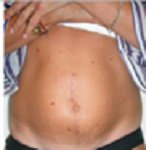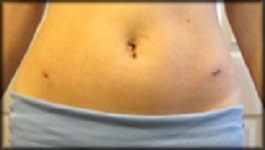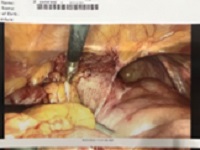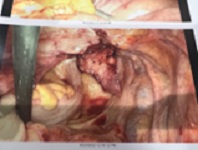Vaginal Mesh Complications
Failed Sacralcolpopexy – August 2022
A year-old patient from North Carolina had a sacralcolpopexy 19 years ago at Greenville Hospital (South Carolina). She came to Drs Miklos & Moore with recurrent vaginal vault prolapse (i.e., failed sacralcolpopexy), cystocele, rectocele and stress urine incontinence.
The patient had seen a number of surgeons who either refused to do her surgery or wanted to perform the surgery through a large abdominal incision i.e., laparotomy.


Laparotomy Incision
Laparoscopy Incision
Dr. Miklos explained to the patient that few surgeons will approach her recurrent prolapse laparoscopically because of the severe adhesions so often associated with previously implanted mesh. She was diagnosed with: Grade 2 prolapse including vaginal vault prolapse, cystocele, rectocele and stress urine incontinence. Dr. Miklos explained to the patient she would need to have a sacralcolpopexy mesh revision and replacement sacralcolpopexy, paravaginal repair, Burch urethropexy and posterior repair. This surgery usually takes approximately 2 hours if the patient did not have a previous mesh graft sacralcolpopexy.
The surgery was completed laparoscopically but took approximately 4 hours due to the severe adhesions between the intestines and the old sacralcolpopexy mesh. The mesh was dissected free from the adhesions and the mesh was then cut near the vaginal vault (apex) of the vagina. See Photo 1 and Photo 2.


Mesh dissected from intestines
Mesh cut at the vaginal vault
A new piece of mesh was then attached to the mesh on her vagina and then sutured to her sacrum (presacral ligament). The surgery was performed laparoscopically (without complications and with only 1 tablespoon of blood loss.
Though previous sacralcolpopexy patients can have recurrent vault prolapse, it is very rare. More importantly, a failed sacralcolpopexy can be approached and repaired laparoscopically in the hands of an experienced surgeon. Drs. Miklos &Moore repaired this patient failed sacralcolpopexy by revising her old mesh using a laparoscopic approach and adding new mesh to her old mesh and attaching it to the sacrum.

